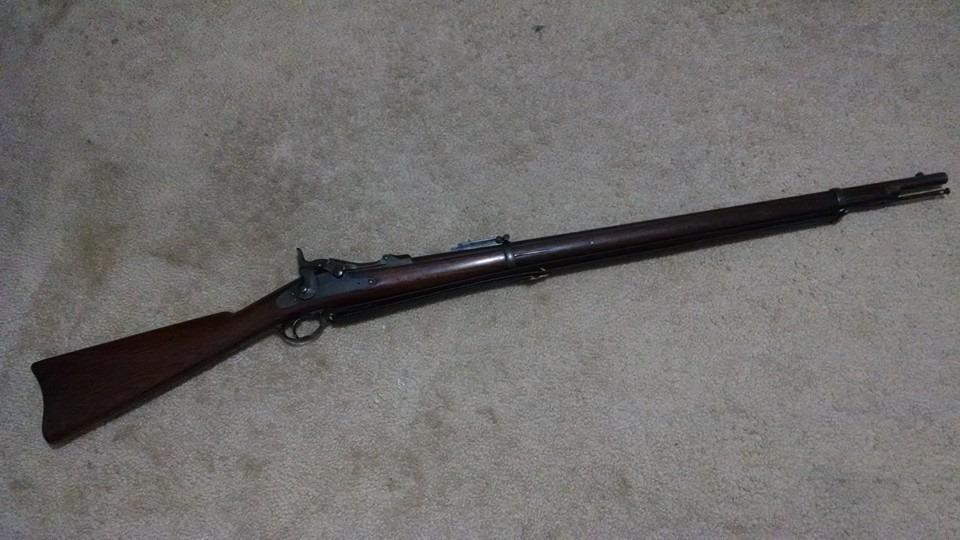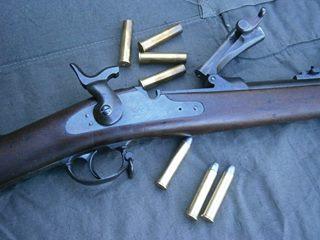
In practice, we didnt get quite the fine accuracy out of the Officers Model as we did with the rifle, though we got what was probably enough accuracy.

This rifle was a bit handier than the full-length rifle, and that might be important if you wanted to use it for hunting, or for specific Cowboy Action events. We messed with it until we had shots hitting near where we looked, and then left it strictly alone. We peered through the aperture and lined it up with the front sight, and with that U-notch, to get the aperture located close to where it should have been. We found the big, fixed U-notch rear sight handy here. The aperture also moved sideways when you loosened it, so you had double trouble for windage. There were no reference marks, but we suspect experienced shooters will soon make some. But if you loosened it, especially if you loosened it too much or too quickly, you lost what you had previously set. It had a knurled outer surface to permit that. The aperture was adjustable for elevation in that the aperture itself was a screw that tightened itself to the upright ladder. There was a big U-shaped notch in the top of the action that served as a super-fast rear sight. The aperture was not really the only rear sight. The front was a big gold dot on top of a post, and you had the option of drifting it to correct windage, though this was also handled by the aperture rear sight. The sights were also distinctly different. Workmanship throughout was on a par with the other rifle, so your extra money would go for all the little touches that including the checkering, which was well-enough done, but by no means perfectly pointed up. The pores were slightly open, and the oil-like matte finish to the wood permitted seeing the grain easily. The stock finish on this model was about the same overall quality as on the full-length rifle. Unset, it broke at just over 4 pounds, with some creep. Pushed forward and set, the trigger broke at 4.5 ounces. In fact, during our shooting tests we used the trigger normally, to get an idea of this rifles performance compared with the standard rifle. The trigger had an adjustment for its set letoff, but we left it alone. The trigger guard, butt plate, aperture sight ladder, and single-set trigger were nicely case colored. The hammer and its lockplate were left white. The opening lever was blued, as was the aperture sight and its base. The action was also case colored, in addition to the breech block, and it was an attractive job. There was one barrel band, not two, and it was case-colored. The 26-inch barrel was as well polished and blued as on the full-length rifle, and it had a tube added beneath it to accept the wood ramrod. However, during our brief shooting, we noted the ramrod overcame its springiness and trick lock and began to move forward, so keep a close eye on yours if you buy and shoot one of these.

The ramrod was of wood, not steel, and had a tricky serrated end that was supposed to keep it within the rifle. The touches on our Officers Model included checkered wood, though the overall wood quality was not a lot, if any, better than on the standard rifle. The short forend of the Officer had a beautifully inletted, graceful metal cap that was polished and left in the white.

If youre interested, Pedersoli also offers a carbine version, which is overall the same size as the Officers Model, but without the nice touches. This was a shorter, lighter, and generally more attractive version of the regular Pedersoli Trapdoor Rifle.

Though they did not expect perfect function nor outstanding accuracy from the original (in fact it had an internal problem and they were not able to test fire it), they were interested in the overall handling qualities it might have, compared with the new ones. 45-70 (about $1,100), and compared it in handling to an original full-length version. Gun Tests Magazine took a look at the Pedersoli Officers Model 1873 Trapdoor. Buffalo Bores lever ammunition and other brands specifically intended for use in modern single-shot rifles and other weapons with strong breech designs have no place in Trapdoors, neither old nor new ones. The Trapdoor gets its name from its top-opening, hinged breech, which is no paragon of strength but adequate for the hottest black-powder loads of its heyday, and for many normal 45-70 loads of today, or at least reproductions are. armed forces from 1873 until it was supplanted by the Krag around 1892. The Trapdoor Springfield has a golden history, having been used by the U.S.


 0 kommentar(er)
0 kommentar(er)
